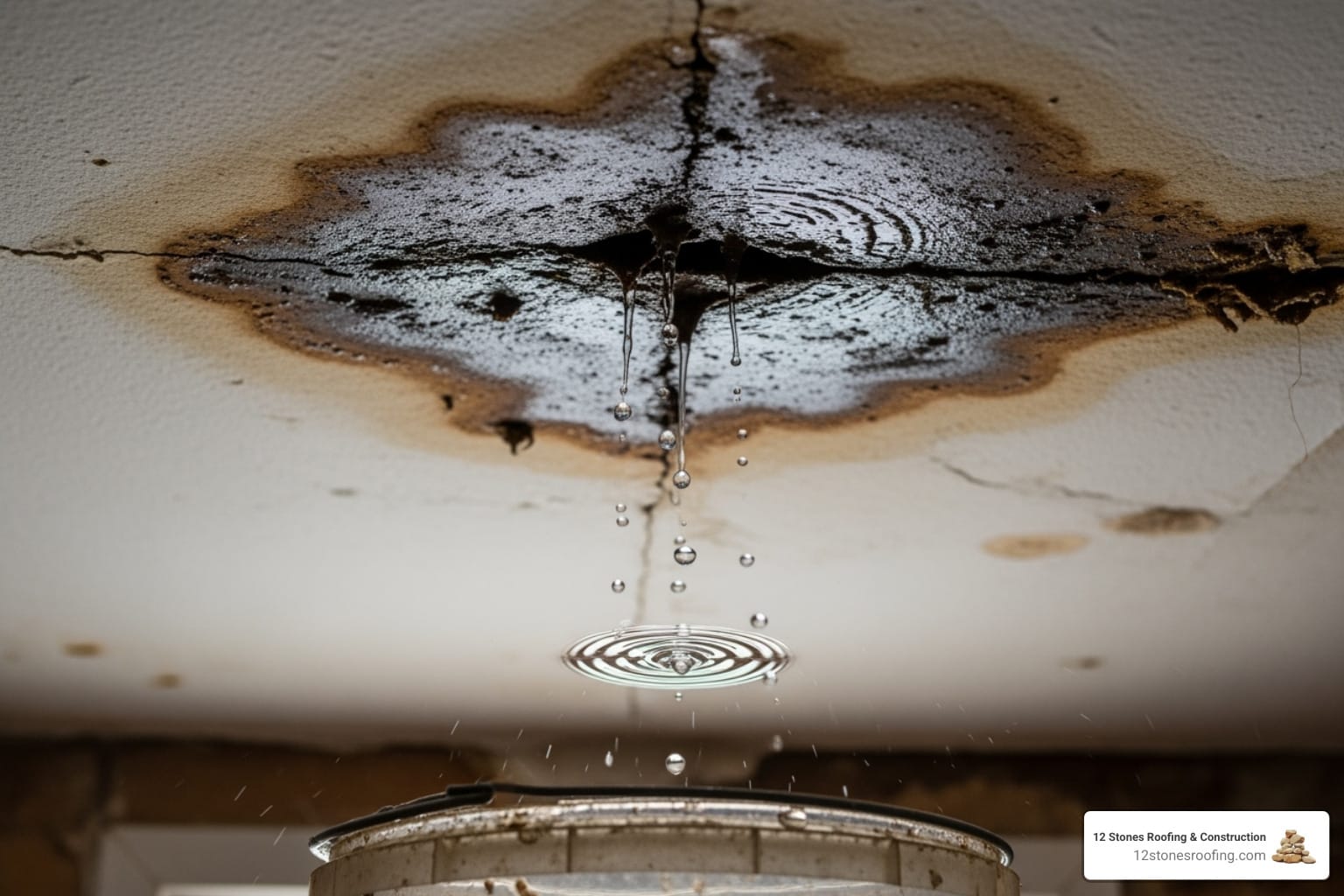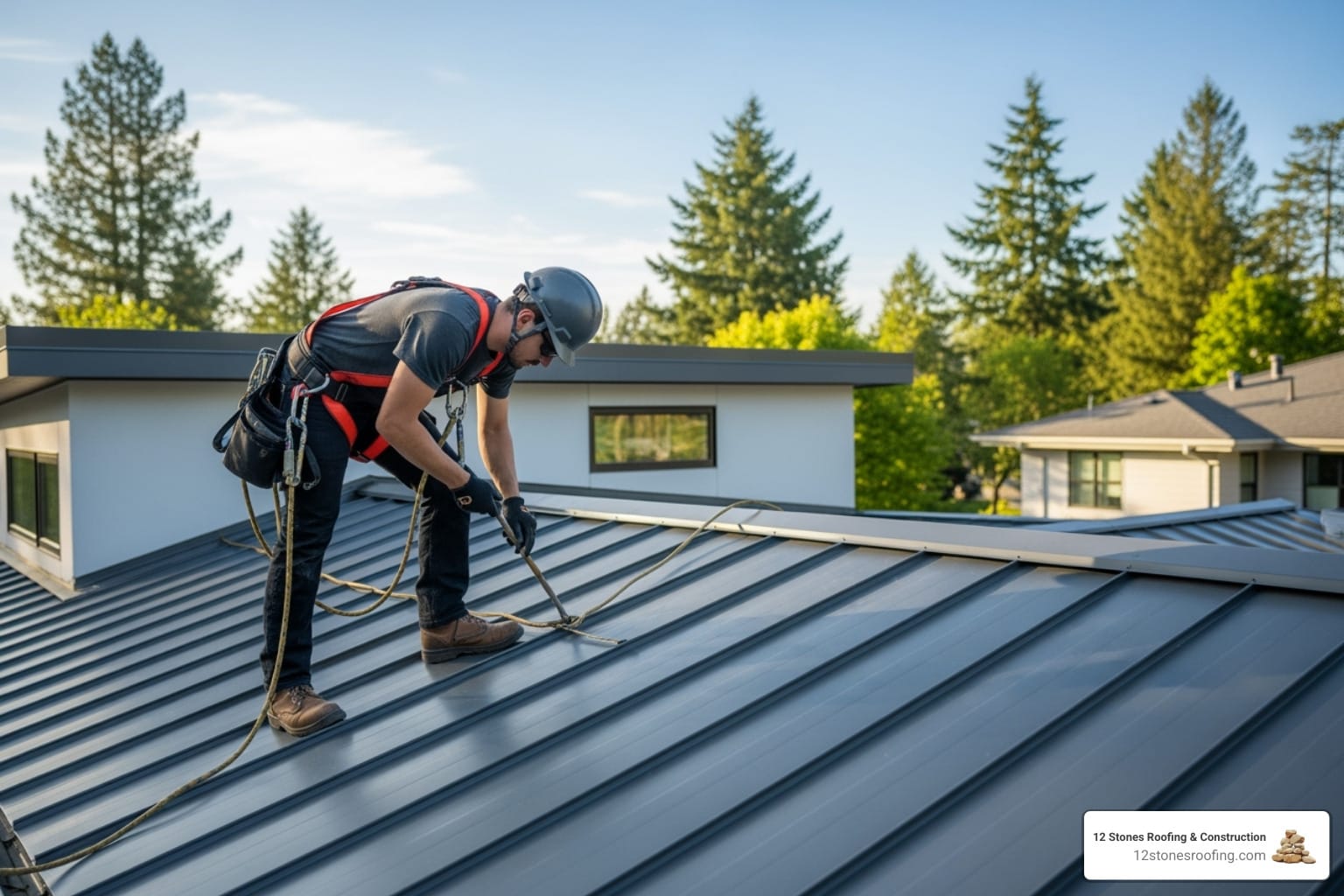Why Your Metal Roof is Worth Protecting
Residential metal roof repair is a critical service for homeowners looking to preserve one of their property’s most valuable assets. A metal roof is a significant investment, built to last 40-70 years—far longer than asphalt shingles. They also reflect solar heat, which can reduce cooling costs by up to 25%. For homeowners in hot climates like Pasadena, TX, this makes them an excellent long-term asset. Timely repairs for issues like minor leaks, loose fasteners, or rust can extend your roof’s lifespan and prevent costly replacements.
Quick Answer: Finding Residential Metal Roof Repair Services
- DIY Costs: For minor issues like loose screws or small rust spots, expect to spend $50-$200 on materials.
- Professional Costs: Leaks, panel replacements, or extensive damage typically cost $300-$1,000+.
- When to Call a Pro: Call for extensive damage, safety concerns, warranty protection, or complex standing seam repairs.
- Emergency Situations: Contact local certified contractors immediately for active leaks or storm damage.
- For Pasadena, TX homeowners: 12 Stones Roofing & Construction offers Service-Disabled Veteran-Owned expertise with manufacturer certifications.
Even the most durable metal roofs can be damaged by severe weather, thermal expansion, or improper installation. Left unaddressed, small issues can escalate into major leaks and structural problems. The good news is that most metal roof problems are highly repairable when caught early.
“I’ve personally overseen countless residential metal roof repair projects throughout the Gulf Coast region,” says Jason Roberts, Owner of 12 Stones Roofing & Construction. “My team holds certifications with top manufacturers, ensuring every repair meets the highest industry standards.”
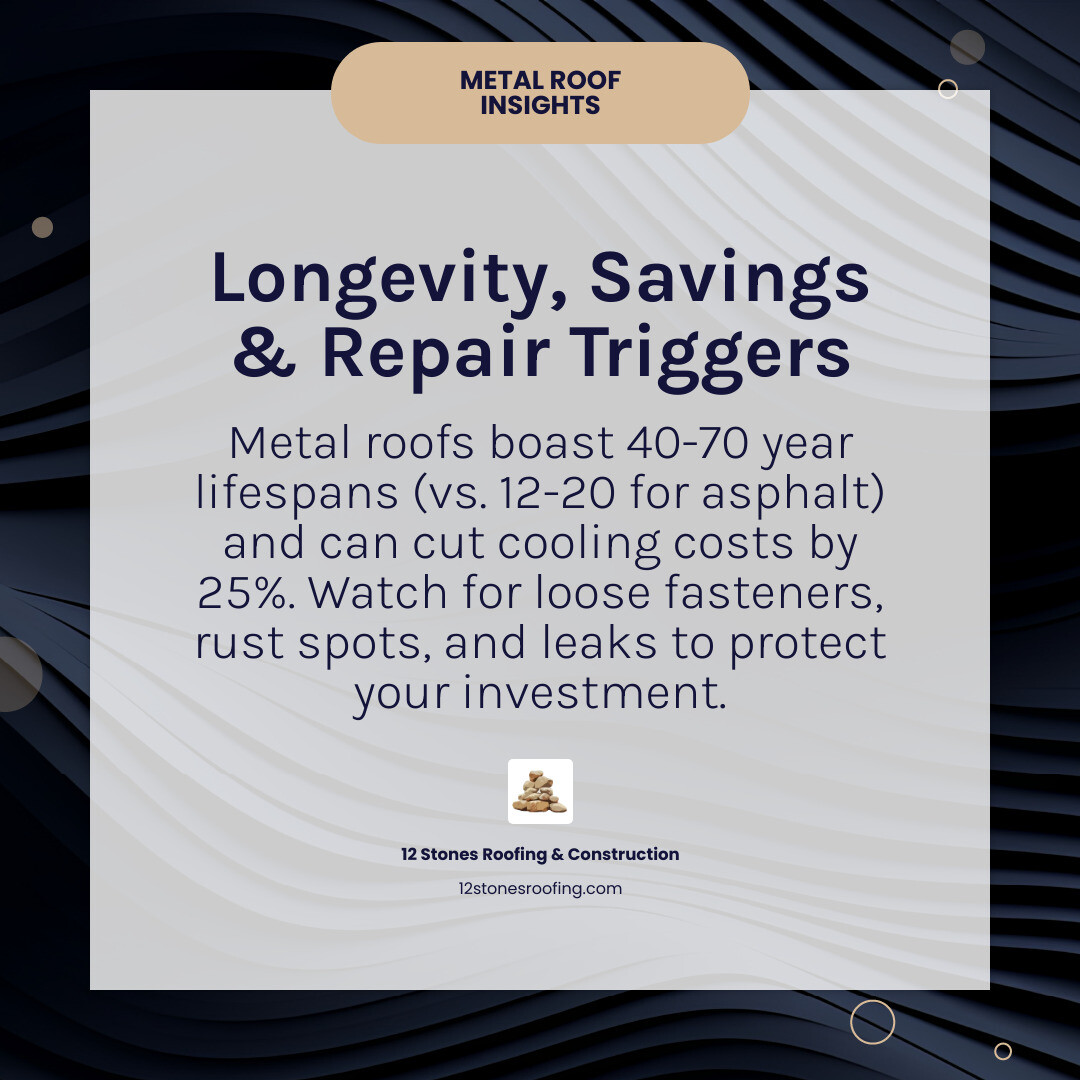
Identifying Metal Roof Problems: 7 Telltale Signs and Their Causes
Learning to spot the signs of a failing metal roof is the difference between a simple residential metal roof repair and a costly replacement. For homeowners in Texas, where weather can be unpredictable, knowing what to look for is essential for any effective roof repair strategy.
Common Causes of Metal Roof Damage
Understanding the root cause of damage helps prevent future issues. Here are the most common culprits:
- Improper Installation: Misaligned panels, incorrect fastener tension, or poor flashing seals are the leading cause of premature roof failure.
- Loose or Failed Fasteners: Metal roofs expand and contract with temperature changes (thermal movement), which can cause screws to back out over time, creating entry points for water.
- Debris Buildup: Leaves and branches trap moisture against the roof surface, accelerating corrosion, especially on steel roofs.
- Environmental Factors: Coastal salt air speeds up corrosion, while high humidity and frequent rain test every seal and fastener.
- Hail Damage: Severe storms can dent or puncture metal panels, compromising their protective coatings. If you’ve been through a hailstorm, learn more about specific hail damage repairs.
- Weathering and Age: Over decades, UV rays, wind, and rain cause paint finishes to fade and protective coatings to break down, making the metal underneath more vulnerable.
Signs Your Metal Roof Needs Immediate Attention
If you notice any of these warning signs, it’s time to take action:
- Visible Water Leaks or Stains: Discoloration or drips on your ceiling mean your roof is actively leaking and requires immediate attention to prevent structural damage.
- Rust or Corrosion Spots: Orange or reddish-brown spots indicate the protective coating has failed and the metal is oxidizing. This will spread if not treated.

- Dents or Punctures: Small punctures from hail or debris create pathways for water.
- Loose or Rattling Panels: Panels that are not properly secured can be lifted by high winds, leading to significant water intrusion and structural damage.
- Deteriorating Sealant: Sealant around vents, skylights, and chimneys that is cracked, brittle, or peeling is no longer waterproof.
- Backed-Out or Missing Screws: Each loose or missing fastener is a potential leak point and compromises the roof’s wind resistance.
- Scratches in the Paint Finish: Deep scratches expose bare metal to the elements, creating a starting point for rust.
The DIY vs. Professional Residential Metal Roof Repair Decision
When you find a problem with your metal roof, you have to decide: handle it yourself or call a professional? While DIY can save money on labor, roofing work carries risks. Making the wrong call can lead to injury, more extensive damage, or voiding your roof’s warranty. This section weighs the pros and cons to help you decide.
Essential Safety and DIY Repair Basics
Safety is non-negotiable when working on a roof, especially a metal one that can be slippery. Before starting, ensure you follow these precautions:
- Ladder Safety: Use a stable ladder on level ground that extends three feet above the roofline.
- Fall Protection: For steep roofs, a safety harness secured to a proper anchor point is essential.
- Proper Gear: Wear non-slip, rubber-soled footwear. Never work on a wet or frosty roof.
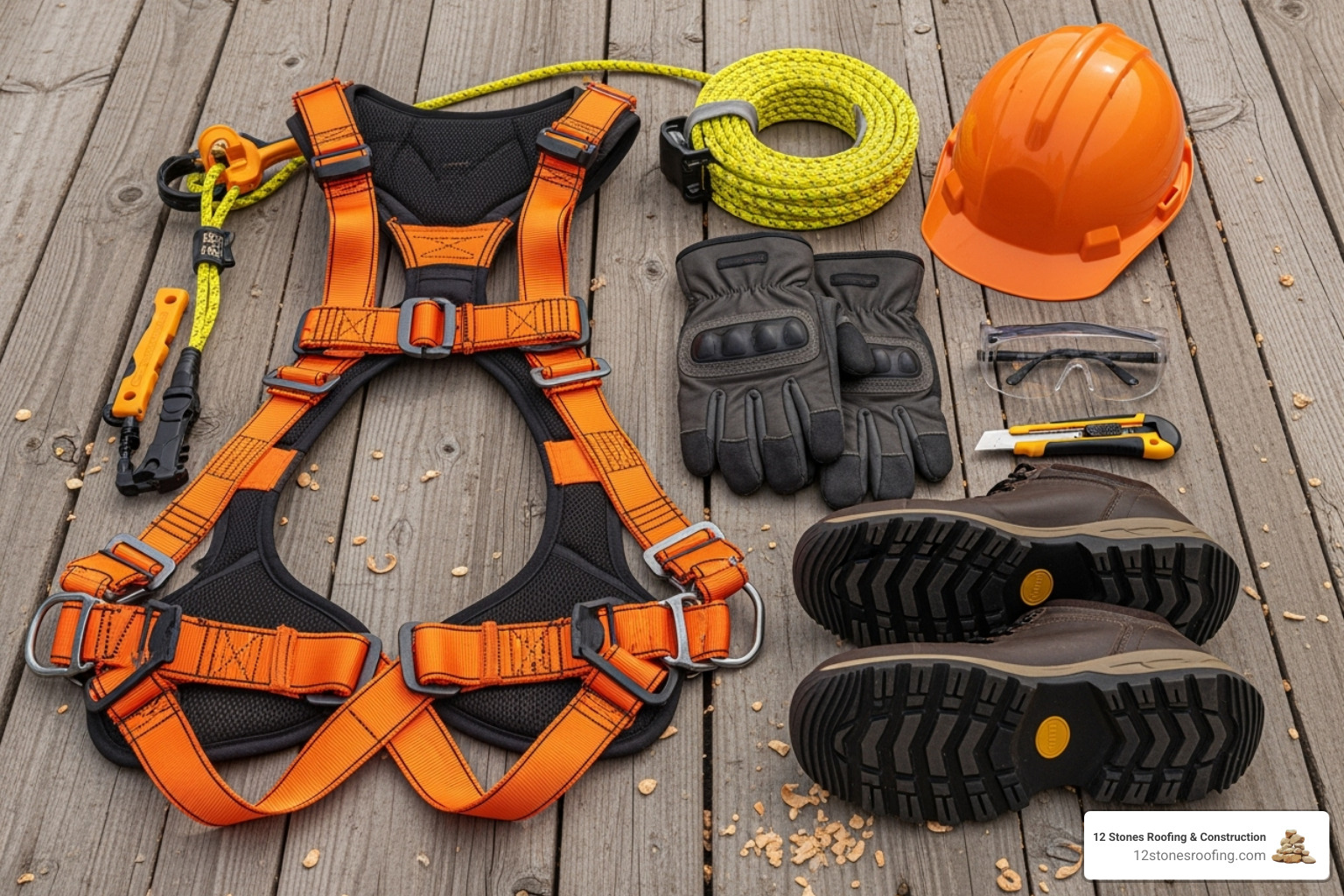
For minor fixes, you’ll need the right materials: high-quality roofing sealant (silicone or polyurethane-based), replacement fasteners with sealing washers, a wire brush, sandpaper, and rust inhibitor. Always choose materials compatible with your existing roof, as some sealants react poorly with certain metals. For technical guidance, GSA offers a guide to repairing sheetmetal roofs.
Step-by-Step Guide to Common Residential Metal Roof Repair Tasks
If you’re comfortable with heights, these common residential metal roof repair tasks may be within your skill set:
- Fixing Loose Fasteners: Carefully tighten loose screws with a drill on a clutch setting to avoid stripping. Replace any fasteners with deteriorated washers.
- Repairing Small Holes: Clean the area, cut a metal patch that overlaps the hole by two inches, and apply roofing cement to the patch and the roof. Press the patch firmly and secure it with screws, then seal the edges and screw heads.
- Sealing Minor Leaks: Locate the source, clean the area thoroughly, and apply a fresh bead of high-quality metal roofing sealant into the seam or around the flashing.
- Treating Rust: Use a wire brush to remove all corrosion down to the bare metal. Clean the area, apply a rust inhibitor, then prime and paint to match your roof.
When to Call a Professional for Residential Metal Roof Repair
While DIY is suitable for minor issues, some situations require professional expertise:
- Extensive Damage: Multiple punctures, large tears, or widespread panel damage require a professional assessment.
- Large Leaks or Structural Issues: If you suspect structural damage or can’t find the source of a major leak, call an expert.
- Safety Concerns: If your roof is steep, high, or you’re uncomfortable with heights, schedule service with a certified contractor. No repair is worth a fall.
- Lack of Experience: If you’re unsure about any step, a professional can prevent a small problem from becoming a costly mistake.
- Warranty Protection: Many manufacturer warranties are voided by DIY repairs. A professional roofing warranty assessment is crucial. As certified contractors, we perform repairs that maintain your warranty coverage.
Understanding the Costs: DIY vs. Professional Repair
When it comes to residential metal roof repair, professional services typically range from $300 to $1,000, while DIY materials may only cost $50 to $200. However, the DIY price doesn’t account for your time, safety risks, or the potential to void your warranty. An improper repair can end up costing more if a professional is needed to fix the original problem and the attempted solution.
Comparing DIY vs. Professional Repair Costs
The table below breaks down the true cost comparison for a residential metal roof repair:
| Factor | DIY Repair | Professional Repair |
|---|---|---|
| Material Cost | $50 – $200 (for minor fixes) | Included in total |
| Labor Cost | Your time | $250 – $800+ (for typical repairs) |
| Tools | Purchase required (can be significant) | Included (contractor owns) |
| Warranty | Voids existing (often) | Often includes workmanship warranty |
| Risk | High (safety, further damage, ineffective) | Low (insured professionals, expert execution) |
| Typical Job | Minor sealant, single fastener, rust spot | Leaks, panel replacement, extensive issues |
For a simple job like tightening a few screws, a DIY approach might seem reasonable. But for larger leaks or panel damage, material costs can quickly rise to $300-$600, not including specialized tools. A professional can complete most repairs in hours, while a DIY project could take a full weekend.
Factors That Influence Professional Repair Costs
Several key factors shape the final price of a professional residential metal roof repair:
- Extent of Damage: Sealing a single leak is far less expensive than replacing multiple hail-damaged panels.
- Roof Accessibility and Pitch: A steep, multi-story roof requires more time and safety equipment, increasing labor costs.
- Type of Metal: Standard steel is easier to work with than copper, which requires specialized techniques. Standing seam systems are more complex to repair than exposed fastener panels.
- Local Labor Rates: Costs vary by region, especially in areas with high demand due to frequent severe weather.
- Panel Replacement: Sourcing a matching panel and installing it seamlessly requires skilled labor and adds to the cost.
- Emergency Repairs: Urgent service after a storm often comes at a premium due to immediate scheduling and difficult working conditions.
We believe in transparent pricing. That’s why we provide detailed estimates upfront. If budget is a concern, flexible financing options are available to help you protect your home.
Material Matters: How Your Roof Type Affects Repairs
Not all metal roofs are the same. The material, panel type, and finish all play a significant role in how a residential metal roof repair is performed. Understanding these differences is key to effective maintenance.
Repair Needs for Steel, Aluminum, and Copper Roofs
Each metal has unique properties that influence repair methods:
- Steel: The most common material, valued for its strength. It’s coated for corrosion resistance, but if the coating is scratched, steel can rust. Repairs involve cleaning rust, applying inhibitors, and repainting.
- Aluminum: Naturally rust-resistant, making it ideal for coastal areas. It’s lighter and more prone to denting from hail but won’t corrode. It also expands and contracts more than steel, which can stress fasteners if not installed correctly.
- Copper: Prized for its longevity and aesthetic patina. It’s expensive and requires specialized repair techniques like soldering due to significant thermal movement. This is not a DIY-friendly material.
Standing Seam vs. Exposed Fastener Panels
The panel connection system dictates the repair strategy.
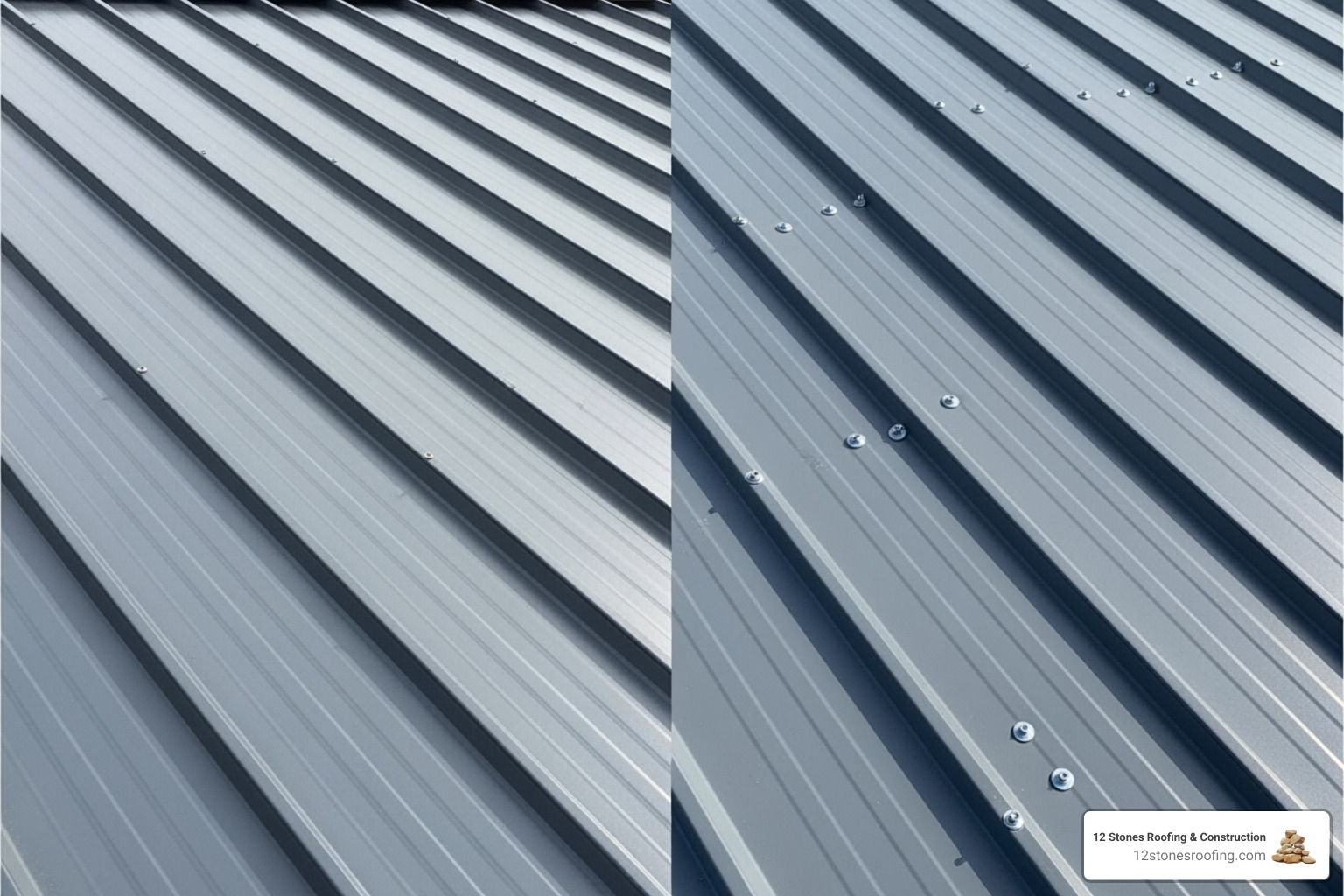
- Standing Seam Repair: These roofs have concealed fasteners for superior weather protection. However, replacing a damaged panel is complex, requiring special tools to disengage the interlocking seams without damaging adjacent panels.
- Exposed Fastener Maintenance: On these roofs, screws are driven through the panels. This makes them more economical but exposes fasteners to the elements. The most common repair involves tightening or replacing fasteners with failing washers. A technical bulletin on panel repair offers more detailed insights.
The Role of Paint Finishes and Coatings
The finish on your roof is a critical protective layer.
- Paint Scratches: A deep scratch exposes the metal, allowing rust to start. Prompt touch-ups are essential.
- Fading and Chalking: Over time, paint degrades from sun exposure, reducing its protective qualities and energy efficiency.
- Kynar 500 vs. SMP: High-performance coatings like Kynar 500 offer superior protection against fading and chalking compared to standard silicone-modified polyester (SMP) paints.
- Re-coating vs. Replacement: If the finish is failing but the metal is sound, professional re-coating can extend the roof’s life. However, if corrosion is widespread, replacement is often necessary.
Proactive Care: Preventing Future Metal Roof Repairs
The best repair is one you never have to make. While metal roofs can last 40-70 years, proactive maintenance is the key to maximizing that lifespan and avoiding costly residential metal roof repair bills. A little effort now saves significant headaches later.
Your Essential Metal Roof Maintenance Checklist
Regular vigilance is your best defense. Follow this checklist to keep your roof in prime condition:
- Inspect Regularly: Visually inspect your roof from the ground twice a year and after every major storm. Look for loose fasteners, cracked sealant, rust, or dents.
- Clean Gutters: Clogged gutters cause water to back up onto the roof, which can lead to corrosion. Keep them clear to ensure proper drainage.
- Clear Debris: Remove fallen leaves, twigs, and other debris from the roof surface, especially in valleys. Trapped debris holds moisture against the metal.
- Check Fasteners and Sealant: On exposed fastener roofs, tighten any loose screws and replace those with worn washers. Reapply sealant around flashing if it appears cracked or brittle.
- Trim Overhanging Branches: Pruning trees prevents branches from falling and puncturing your roof during a storm.
For a more detailed guide, our roof maintenance checklist can help you stay on track.
The Importance of Regular Professional Inspections
While DIY checks are valuable, nothing replaces a professional’s trained eye. An expert roof inspection can identify subtle signs of wear that an untrained eye might miss. Our technicians can spot everything from tiny flashing defects to the early stages of coating degradation. Identifying these issues early allows for preventative measures that extend your roof’s life and save you from major repairs. A professional inspection every one to two years is a small investment that provides significant peace of mind and can be invaluable for insurance purposes.
Your Next Steps for a Secure and Lasting Metal Roof
Your metal roof is a smart investment, offering decades of protection and energy savings. Whether you’ve spotted a minor issue or are dealing with a serious leak, addressing problems promptly is key to preserving that investment. A small repair today can prevent a major replacement tomorrow.
We’ve covered how to identify damage, when to DIY, and when to call a professional for residential metal roof repair. For homeowners in Pasadena and surrounding areas, an experienced, local contractor is your best bet for a reliable, long-lasting repair that stands up to Texas weather.
Proactive care goes a long way, but when repairs are needed, you deserve a team that provides honest advice and expert service. We’re here to help you steer the complexities of metal roof care with transparent pricing and straightforward solutions.
Ready to ensure your roof is in top condition? Call us today for a free, no-obligation inspection. We’ll assess your roof’s condition, answer your questions, and provide a clear path forward to protect your home.



